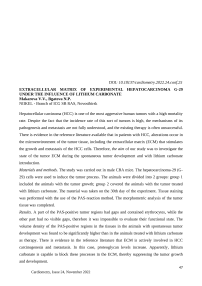Extracellular matrix of experimental hepatocarcinoma G-29 under the influence of lithium carbonate
Автор: Makarova V.V., Bgatova N.P.
Журнал: Cardiometry @cardiometry
Статья в выпуске: 24, 2022 года.
Бесплатный доступ
Hepatocellular carcinoma (HCC) is one of the most aggressive human tumors with a high mortality rate. Despite the fact that the incidence rate of this sort of tumors is high, the mechanisms of its pathogenesis and metastasis are not fully understood, and the existing therapy is often unsuccessful. There is evidence in the reference literature available that in patients with HCC, alterations occur in the microenvironment of the tumor tissue, including the extracellular matrix (ECM) that stimulates the growth and metastasis of the HCC cells. Therefore, the aim of our study was to investigate the state of the tumor ECM during the spontaneous tumor development and with lithium carbonate introduction.
Короткий адрес: https://sciup.org/148326318
IDR: 148326318 | DOI: 10.18137/cardiometry.2022.24.conf.25
Текст статьи Extracellular matrix of experimental hepatocarcinoma G-29 under the influence of lithium carbonate
NIIKEL - Branch of ICG SB RAS, Novosibirsk
Hepatocellular carcinoma (HCC) is one of the most aggressive human tumors with a high mortality rate. Despite the fact that the incidence rate of this sort of tumors is high, the mechanisms of its pathogenesis and metastasis are not fully understood, and the existing therapy is often unsuccessful. There is evidence in the reference literature available that in patients with HCC, alterations occur in the microenvironment of the tumor tissue, including the extracellular matrix (ECM) that stimulates the growth and metastasis of the HCC cells. Therefore, the aim of our study was to investigate the state of the tumor ECM during the spontaneous tumor development and with lithium carbonate introduction.
Materials and methods . The study was carried out in male CBA mice. The hepatocarcinoma-29 (G-29) cells were used to induce the tumor process. The animals were divided into 2 groups: group 1 included the animals with the tumor growth; group 2 covered the animals with the tumor treated with lithium carbonate. The material was taken on the 30th day of the experiment. Tissue staining was performed with the use of the PAS-reaction method. The morphometric analysis of the tumor tissue was completed.
Results . A part of the PAS-positive tumor regions had gaps and contained erythrocytes, while the other part had no visible gaps, therefore it was impossible to evaluate their functional state. The volume density of the PAS-positive regions in the tissues in the animals with spontaneous tumor development was found to be significantly higher than in the animals treated with lithium carbonate as therapy. There is evidence in the reference literature that ECM is actively involved in HCC carcinogenesis and metastasis. In this case, proteoglycan levels increase. Apparently, lithium carbonate is capable to block these processes in the ECM, thereby suppressing the tumor growth and development.
Conference Proceedings
Conclusions . The state of the ECM is an indicator of the tumor growth. A decrease in the volumetric density of the PAS-positive components in the tumor tissue with the use of lithium carbonate may be a marker of blocking the G-29 growth.
Список литературы Extracellular matrix of experimental hepatocarcinoma G-29 under the influence of lithium carbonate
- Chedid M.F., Kruel C.R.P., Pinto M.A., Grezzana-Filho T.J.M., Leipnitz I., Kruel C.D.P., Scaffaro L.A., Chedid A.D. Hepatocellular carcinoma: diagnosis and operative management. Arq Bras Cir Dig. 2017; 30 (4): 272-278.
- Ogunwobi O.O., Harricharran T., Huaman J., Galuza A., Odumuwagun O., Tan Y., Ma G.X., Nguyen M.T. Mechanisms of hepatocellular carcinoma progression. World J Gastroenterol. 2019; 25 (19): 2279-2293.
- Pickup M.W.; Mouw J.K.; Weaver V.M. The extracellular matrix modulates the hallmarks of cancer. EMBO Rep. 2014; 15: 1243-1253.
- Nault J.-C., Guyot E., Laguillier C., Chevret S., Ganne-Carrie N., N'Kontchou G., Beaugrand M., Seror O., Trinchet J.-C., Coelho J. Serum proteoglycans as prognostic biomarkers of hepatocellular carcinoma in patients with alcoholic cirrhosis. Cancer Epidemiol. Biomark. 2013; Prev. 22: 1343-1352.


